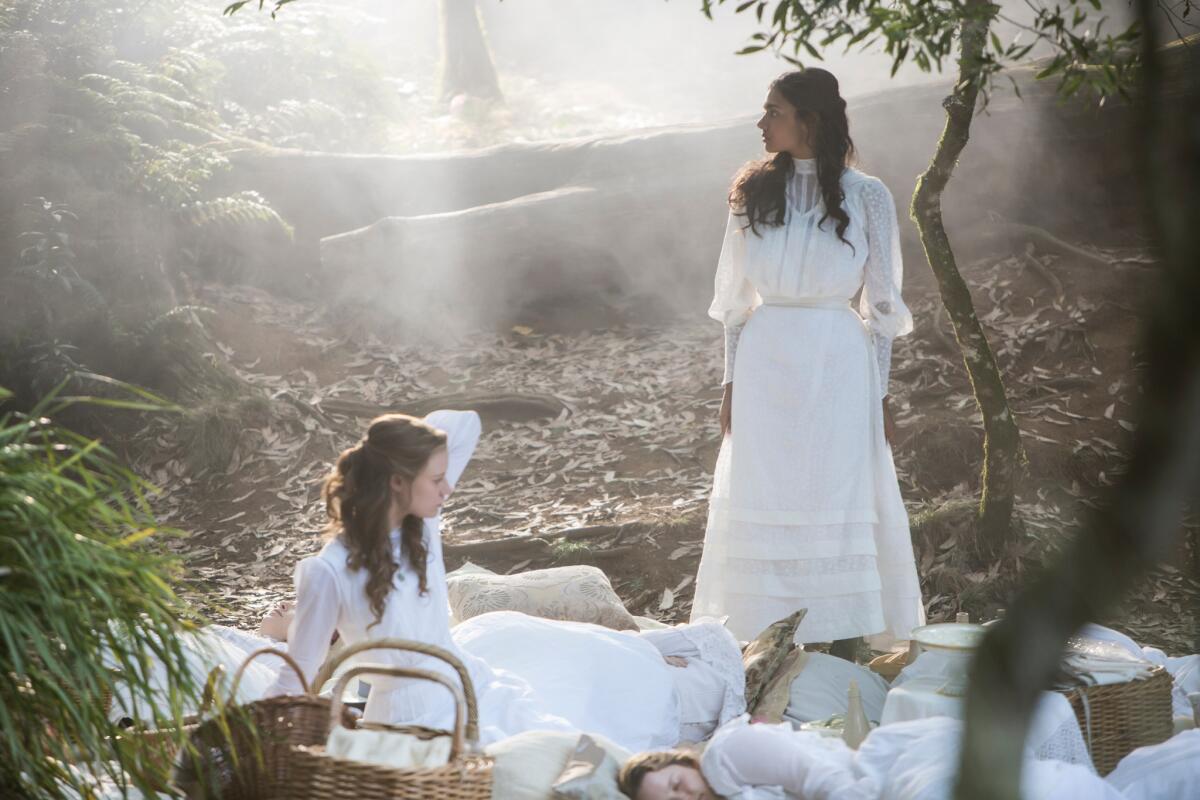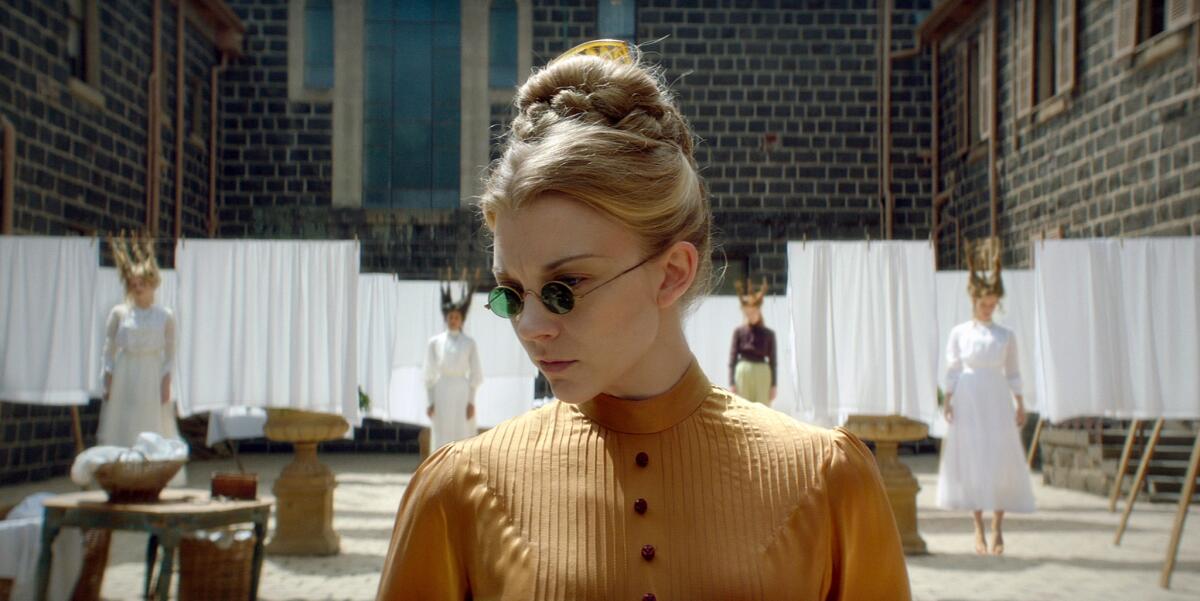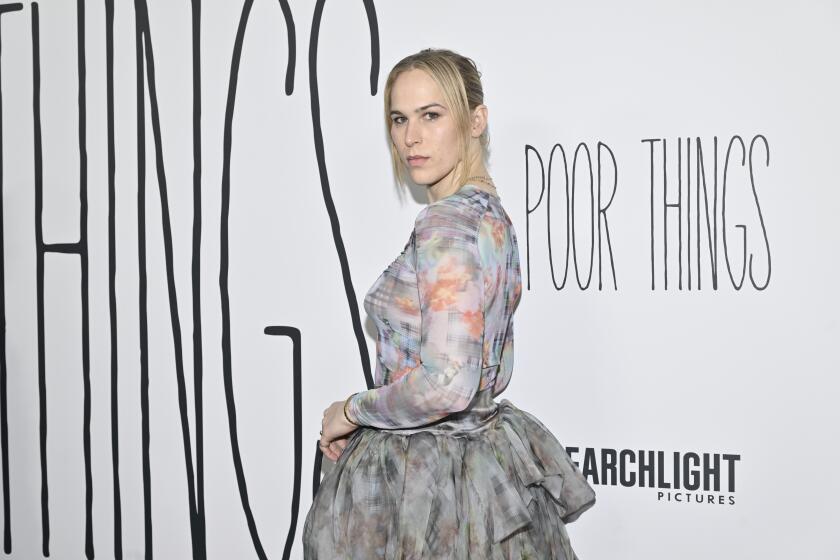Review: It’s an overheated ‘Picnic at Hanging Rock’ that Baz Luhrmann might love
Joan Lindsay's 1967 novel "Picnic at Hanging Rock," published in Australia, where it has national landmark status, is a sort of mystic mystery somewhat in the form of a case study. Adapted for film in 1975, it launched the career of director Peter Weir; now it has become a six-hour television series, premiering Friday on Amazon Prime.
I am not divulging any secrets — it's on a title card even before the action begins — to say that it is the story of four women who disappear on a school outing to a geological marvel on St. Valentine's Day 1900, and what happens afterward.
Miranda (Lily Sullivan), Marion (Madeleine Madden) and Irma (Samara Weaving) are the cool seniors at Mrs. Appleyard's College for young ladies. Miranda is the wildest, Marion the smartest and Irma the richest. Attached to them are Sara (Inez Currõ), the school's littlest student, who dotes exclusively upon Miranda, and Edith (Ruby Rees), described by Lindsay as "the College dunce," who just doesn't want to be left out, though she is a pill wherever she is.

There is an extra measure of skulking and plotting, of cruelty bordering on pathology. Religious mania makes a cameo.
On a sometimes intersecting track, we meet young Englishman Michael (Harrison Gilbertson), who prefers to be called Mike, and his new friend Albert (James Hoare), the tattooed coachman of the well-to-do aunt and uncle with whom he's staying. Michael, having once glanced Miranda, cannot get her out of his mind.
The formidable Mrs. Appleyard, 57 in the book, is played here by 36-year-old Natalie Dormer ("Game of Thrones"); an older doctor has also been de-aged into the person of 42-year-old actor Don Hany, the better to create intimacy with Appleyard. Conversely, the main schoolgirls, not unusually, are all a little old for their parts, dialing up the mostly repressed sexual tensions considerably.

Stretching the material to six hours allows the adaptation (originally for the Australian premium network Foxtel) to hit most of the book's plot points. And where it doesn't, it's clearly a choice to reflect the filmmakers’ own concerns, where they want to make the material more exciting or “relevant” — largely to reflect contemporary issues involving gender and sexual parity — which is also to say more commercial. (Larysa Kondracki, who made the Rachel Weisz film "The Whistleblower," is the miniseries' main director, Beatrix Christian its primary screenwriter.) It adds new scenes, supplies or makes explicit motivations and histories that Lindsay left vague or mysterious or did not bother with at all, in ways that tend to make the characters less complicated and more familiar. There is an extra measure of skulking and plotting and people rifling through one another's stuff, of cruelty bordering on pathology. Religious mania makes a cameo.
Where Weir’s film was still and dreamy, the miniseries, which tends to hammer home its points, is not really in the spirit of Lindsay's prose, which remains measured even when it becomes ecstatic.
There is no reason that an adaptation can't go its own way — this one has been conveniently described as a "re-imagining" — but even taken without reference to the novel, this "Picnic" is overheated, so pumped up with strangeness and dread that when something actually strange or dreadful does happen, it doesn't quite register — it's just another moment of weirdness in a vast sea of weird.

Indeed, it is at its most uncanny at its most subtle, though it is rarely subtle. Similarly, whatever is natural in the performances has to fight its way through a thick patina of stylishness, and it does not always make it.
To be fair, the fanciness does at times serve the meaning. Where Lindsay writes, summing up the novel's concern with human artifice in a natural world, time and timelessness, "Insulated from natural contacts with earth, air and sunlight, by corsets pressing on the solar plexus, by voluminous petticoats, cotton stockings and kid boots, the drowsy well-fed girls lounging in the shade were no more part of their environment than figures in a photograph album, arbitrarily posed against a backcloth of cork rocks and cardboard trees," the image is handsomely, if somewhat literally, translated into a shot in which the figures are sharpened and the background blurred.
More often, "Picnic at Hanging Rock" is a riot of slow motion, shallow focus, Grand Guignol lighting effects, "Batman" camera angles and "Evil Dead" dolly shots. At times, the lens seems to have been strapped to a boat in bad weather. The soundtrack rattles and screeches and thumps.
There might be a generational element to this. To someone raised on music videos and the movies of Baz Luhrmann — another proud product of Australia — this might seem a perfectly reasonable way through the material, even a necessary one.
But it still looks like a music video a lot of the time, modern in a way that will seem dated sooner than later. For some of us, sooner will already be now.
‘Picnic at Hanging Rock’
Where: Amazon Prime
When: Any time, starting Friday
Rating: TV-14 (may be unsuitable for children under the age of 14)
ALSO
Follow Robert Lloyd on Twitter @LATimesTVLloyd
The complete guide to home viewing
Get Screen Gab for everything about the TV shows and streaming movies everyone’s talking about.
You may occasionally receive promotional content from the Los Angeles Times.




